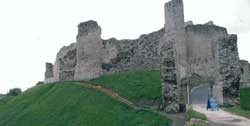 |
 |
 |
 |
 |
 |
 |
|
(2/7) Where were the bodies buried? Whilst the Ecclesiastica Officia, the official customary of the Order, assumed that all burials would take place in the cemetery, members of the community and outsiders might be buried in the church, in the cloister walks or in the chapter-house - the latter was largely reserved for former abbots and dignitaries.
During the Interdict the monks of Meaux Abbey in Yorkshire were buried in the monks’ garden, whereas the abbey servants were buried outside the precinct.(7) From the thirteenth century laity were often buried near the west façade of the church or in side chapels: Matilda, of York, countess of Cambridge, was a generous benefactor of Roche and in her will of 1446 left explicit instructions as to how she should be buried in the abbey church and how her soul should be provided for thereafter. In return the monks of Roche received payment, gifts and presumably secured the goodwill and future benefaction of her successors at nearby Conisbrough Castle. From the late twelfth century the burial of laity in the cloister walks was common but could be hazardous, since the monks might trip over tombstones that were uneven and jutted above the surface. To combat any such accidents the General Chapter ruled in 1191 that the slabs of these graves should be level with the ground.(8)
|
